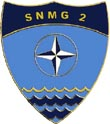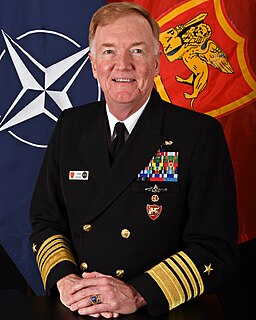
The Sixth Fleet is a numbered fleet of the United States Navy operating as part of United States Naval Forces Europe. The Sixth Fleet is headquartered at Naval Support Activity Naples, Italy. The officially stated mission of the Sixth Fleet in 2011 is that it "conducts the full range of Maritime Operations and Theater Security Cooperation missions, in concert with coalition, joint, interagency, and other parties, in order to advance security and stability in Europe and Africa." The current commander of the Sixth Fleet is Vice Admiral Eugene H. Black III.

Supreme Headquarters Allied Powers Europe (SHAPE) is the headquarters of the North Atlantic Treaty Organization's Allied Command Operations (ACO). Since 1967 it has been located in Casteau, north of the Belgian city of Mons, but it had previously been located, from 1953, at Rocquencourt, next to Versailles, France. From 1951 to 2003, SHAPE was the headquarters of Allied Command Europe (ACE). Since 2003 it has been the headquarters of Allied Command Operations, controlling all NATO operations worldwide.

The British Mediterranean Fleet, also known as the Mediterranean Station, was a formation of the Royal Navy. The Fleet was one of the most prestigious commands in the navy for the majority of its history, defending the vital sea link between the United Kingdom and the majority of the British Empire in the Eastern Hemisphere. The first Commander-in-Chief for the Mediterranean Fleet was the appointment of General at Sea Robert Blake in September 1654. The Fleet was in existence until 1967.

Allied Joint Force Command Brunssum (JFCBS) is a NATO command with its headquarters at Brunssum, the Netherlands. It was established in 2004 from previous commands as part of NATO's continuing command structure reductions in the face of a then-diminishing threat.
Allied Command Operations (ACO) is one of the two strategic commands of the North Atlantic Treaty Organization (NATO), the other being Allied Command Transformation (ACT). The headquarters and commander of ACO is Supreme Headquarters Allied Powers Europe (SHAPE) and Supreme Allied Commander Europe (SACEUR), respectively.

Standing NATO Maritime Group 2 (SNMG2) is a North Atlantic Treaty Organisation (NATO) standing maritime immediate reaction force. SNMG2 consists of four to six destroyers and frigates. Its role is to provide NATO with an immediate operational response capability.

United States Naval Forces Europe-Africa (CNE-CNA), is the United States Navy component command of the United States European Command and United States Africa Command. Prior to 2020, CNE-CNA was previously referred to as United States Naval Forces Europe – Naval Forces Africa (NAVEUR-NAVAF).

Allied Joint Force CommandNaples is a NATO military command based in Lago Patria, in the Metropolitan City of Naples, Italy. It was activated on 15 March 2004, after what was effectively a redesignation of its predecessor command, Allied Forces Southern Europe (AFSOUTH), originally formed in 1951. In NATO Military Command Structure terms, AFSOUTH was a "Major Subordinate Command". The commander of JFC Naples reports to the Supreme Allied Commander Europe at the Supreme Headquarters Allied Powers Europe, Casteau, Belgium.
Operation Active Endeavour was a maritime operation of the North Atlantic Treaty Organization. It operated in the Mediterranean Sea and was designed to prevent the movement of terrorists or weapons of mass destruction. It had collateral benefits in enhanced security of shipping in general. It was one of the first military actions taken by NATO in response to an invocation of Article 5 of the North Atlantic Treaty which provides for collective defense and the first-ever operation conducted by the Alliance indirect application of the defense clause of the Treaty. In November 2016 it was replaced by the non-Article-5 Operation Sea Guardian.

Mark P. Fitzgerald is a retired United States Navy admiral. He is the former Commander, United States Naval Forces Europe – Commander, United States Naval Forces Africa and Commander, Allied Joint Force Command Naples. He previously served as Director, Navy Staff from December 2006 to November 2007 and Commander, United States Second Fleet from 2004 until December 2006. He assumed the duties of Commander, United States Naval Forces Europe and Commander, Allied Joint Force Command Naples on November 30, 2007 and assumed the additional duties as Commander, United States Naval Forces Africa on March 26, 2009.

Operation Sharp Guard was a multi-year joint naval blockade in the Adriatic Sea by NATO and the Western European Union on shipments to the former Yugoslavia. Warships and maritime patrol aircraft from 14 countries were involved in searching for and stopping blockade runners.

Exercise Grand Slam was an early major naval exercise of the newly formed North Atlantic Treaty Organization (NATO). This 1952 combined naval exercise took place in the Mediterranean Sea, and it included a naval force that was described as being "the largest armada to be assembled in that area since the end of World War II." Exercise Grand Slam was an early test for NATO's Allied Forces Southern Europe. With Exercise Longstep, this exercise served as the prototype for future NATO maritime exercises in the Mediterranean Sea during the Cold War.
The Structure of the North Atlantic Treaty Organisation is complex and multi-faceted. The decision-making body is the North Atlantic Council (NAC), and the member state representatives also sit on the Defence Policy and Planning Committee (DPPC) and the Nuclear Planning Group (NPG). Below that the Secretary General of NATO directs the civilian International Staff, that is divided into administrative divisions, offices and other organizations. Also responsible to the NAC, DPPC, and NPG are a host of committees that supervise the various NATO logistics and standardisation agencies.

Exercise Longstep was a ten-day NATO naval exercise held in the Mediterranean Sea during November 1952 under the overall command of Admiral Robert B. Carney, USN, the Commander-in-Chief Allied Forces Southern Europe (CINCAFSOUTH). This exercise involved over 170 warships and 700 aircraft, and it featured a large-scale amphibious assault along the western coast of Turkey. With Exercise Grand Slam, this exercise served as the prototype for future NATO maritime exercises in the Mediterranean Sea during the Cold War.

Allied Maritime Command (MC) Naples was a subordinate command of Allied Joint Force Command Naples. MC Naples operated from the island of Nisida in the Gulf of Pozzuoli and its commander reported directly to the Commander Allied Joint Force Command Naples. The command was deactivated in March 2013.

Allied Maritime Command (MARCOM) is the central command of all NATO maritime forces and the Commander MARCOM is the prime maritime advisor to the Alliance. When directed by the Supreme Allied Commander Europe (SACEUR), it provides the core of the headquarters responsible for the conduct of maritime operations. The command is based at the Northwood Headquarters in northwest London.
Allied Forces Mediterranean was a NATO command covering all military operations in the Mediterranean Sea from 1952 to 1967. The command was based at Malta.

Naval Striking and Support Forces NATO (STRIKFORNATO) is the principal naval service command of the North Atlantic Treaty Organization's (NATO) Allied Command Operations (ACO), replacing Naval Striking and Support Forces Southern Europe (STRIKFORSOUTH). STRIKFORNATO is commanded by Commander United States Sixth Fleet, and it is the only command capable of leading an expanded maritime task force.

James Gordon Foggo III is a retired United States Navy admiral who last served as commander of United States Naval Forces Europe-Africa and commander of Allied Joint Force Command Naples. He previously served as the director of Navy Staff. Prior to that, he served as the commander of United States Sixth Fleet. He assumed his last assignment on October 20, 2017. On July 17, 2020, he relinquished command of United States Naval Forces Europe-Africa and Allied Joint Forces Command Naples to Admiral Robert P. Burke.

Joint Force Command - Norfolk (JFC-NF) is a joint operational level command part of the NATO Military Command Structure under Allied Command Operations. Its headquarters is located in Norfolk, Virginia, United States.